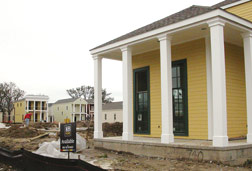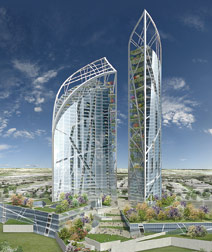...national pool, he says. But the increased homeowner’s insurance premiums are causing “sticker shock for would-be buyers and homeowners,” he says.
Still, the city has its defenders who point the finger at the national belt-tightening by big homebuilders. Arthur Sterbcow, president of Latter & Blum Cos., New Orleans, claims the real estate market is significantly healthier than it was before Katrina. “We are blessed locally because even though the insurance rates have gone to the moon in many areas, we’re still one of the cheapest markets to live in,” he says. Thanks to the new building codes, better engineering for storm resistance, energy and environmental efficiency, properties will be a better risk for insurers, Sterbcow claims.
New Look
Historically, KB and other high-volume builders had not worked in the New Orleans area because large undeveloped parcels were hard to come by. “There is not enough available raw acreage to yield large units,” Luther says. “But post-Katrina, the big boys may have had an epiphany and have been scouting the area even though major planning decisions are still incubating.”
 Angelle Bergeron/ENR KB Home�s 73-lot River Garden project features single-family homes.
|
While the Churchill Farms deal remains a cautionary tale, other projects are moving ahead. KB has seven subdivisions under way in the greater New Orleans and Baton Rouge markets. The 73-lot River Garden project in New Orleans’ lower Garden District features single-family homes while the Madisonville development features 1,653-sq-ft to 1,932-sq-ft townhouses, starting at $169,900. The firm also has plans for four developments in Baton Rouge and the surrounding area.
“KB intends to continue looking for land and building quality homes and communities in Louisiana,” says Caroline Shaw, KB senior vice president. “There is clearly a future in Louisiana, and homes are selling very well in Baton Rouge. New Orleans won’t be far behind.”
“The big surge in construction will be in the second half of 2007 when we start about 5,000 to 10,000 multi-family units here,” Ragas says. “They will all be funded through federal low-income housing tax credits administered by the Louisiana Housing Finance Agency.”
D.R. Horton, Fort Worth, also is expanding in the area, with 14 subdivisions open north and west of the city. The nation’s largest homebuilder had its eye on the area even before the storm hit.
 Studio Daniel Libeskind Jefferson Parish will get twin 35-story towers.
|
“In the greater Baton Rouge area south to Lake Pontchartrain, we will close somewhere between 600 to 900 homes in 2007,” says Rick Horton, south region president. “Last year, we closed about 450 homes. That was our start-up.” According to Horton, “there is a great need” for homes costing under $200,000. But he says the “lot supply and subcontractor base is very difficult to find.”
Other big homebuilders are not moving to the area. “We have no plans for New Orleans because we’d have to start from scratch and we want to be in markets where we already have a presence and infrastructure,” says Mark Marymee, spokesman for Pulte Homes, Bloomfield Hills, Mich.
In a move to encourage high-rise development in New Orleans suburbs, the Jefferson Parish Council in January passed a high-rise zoning resolution that allows certain buildings of unlimited heights. “In theory, I could build 100 stories if I am inclined to do so,” says developer Jim St. Raymond, who hopes to break ground this spring on twin 35-story condominium towers. Although there is some community opposition, the council’s support indicates a transition toward high-rise development.
“People want to live up, as opposed to living on ground level,” St. Raymond says. “Considering the lack of available space, they realize that if the parish is going to grow and get people to come here, they’ll have to go up.”

Post a comment to this article
Report Abusive Comment